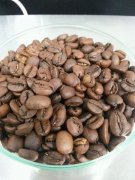Comparison of performance verification of VST and IMS powder bowls for coffee quality of Italian coffee extraction standard
For professional baristas, please follow the coffee workshop (Wechat official account cafe_style)
IMS vs VST: Italian Coffee Powder Bowl and its role in extraction
Italian coffee powder bowls: they are small but powerful. They have a vital effect on extraction, but even so, they are often overlooked.
In fact, VST founder Vince Fedele first unveiled his high-precision powder bowl to the entire coffee industry more than a decade ago, years before technological innovations in boutique coffee equipment, such as PID temperature-controlled multi-boiler coffee machines and immersed heads. Over the past few years, however, attitudes towards espresso powder bowls have been changing.
Today, we have a new brand in the coffee industry as a challenger: IMS. So who is better, IMS or VST? For this reason, I decided to blindly test the flavor of the products of their powder bowls of all sizes.
Although VST is revolutionary, it is not their first to offer a more advanced powder bowl than the original powder bowl of an Italian coffee machine. Synesso's powder bowl, for example, has always been highly respected. However, VST has done sufficient research and analysis on the extraction effect in terms of geometry, pore size and shape, and the hole position and shape of the powder bowl provided ensure consistency.
Before that, most pennies had serious design flaws. Pore sizes vary widely-in the same powder bowl, some fine powders can flow directly through to espresso, while others are small enough to cause clogging.
As a result, VST's pink bowl has monopolized the high-end pink bowl market for many years. You may occasionally hear some baristas complain that there are many problems with VST, but most opinions (including mine) think that these "problems" can be solved by better cloth powder and pressing powder.
Now, a new brand has gone public: IMS. Shortly after the end of World War II, the Italian company began producing metal parts for the espresso industry. Now they have launched the "competition filter bowl" series, and claim to have all the advantages of the VST powder bowl.
Let's verify it now.

Performance Verification Scheme of VST and IMS Powder Bowl
We use these two brands of powder bowls to produce several spaghetti concentrates and blind tests, including Rwandan Cyanika from Colonna Coffee and Tanzanian Hasambo Peaberry baked by RoundHill. Both are light baking, but the flavor develops well.
EK43 is used to grind beans, and our Kee Van der Westen Mirage coffee machine is used. The flow rate is very slow and the pump pressure is 6.5atmosphere. The ratio of water to powder was cooked at two different ratios that were most suitable for the two kinds of beans, but remained the same in all sizes of powder bowl tests for both brands.
Another noteworthy variable is the degree of grinding. We all know that the optimum grindability varies with different bowl sizes, which is obvious because larger bowls contain more coffee powder, which slows extraction, but in theory, different filter sizes of different sizes should be able to correct the difference in extraction speed. In reality, on the premise of maintaining the same ratio of water to powder, if you want the extraction time of a 15g powder bowl to be the same as that of an 18g powder bowl, you need to adjust a scale on the dial of the EK43 bean grinder.
Interestingly, there is a big difference in the degree of grinding that is most suitable for VST and IMS powder bowls of the same size. The IMS powder bowl needs to be refined by 1-1.5 scales to be consistent with the VST powder bowl of the same size. Our conclusion is that this result is probably due to different filter sizes, but the accurate measurement of such a small filter is beyond our ability, so this is only a guess.
Different tastes: the results of our tests
In the blind taste test, the subjects preferred the product of IMS. Most of them feel that the sweetness and taste richness of the products are slightly better, but the difference is minimal. In fact, if it is a coffee drink with milk, you can't taste the difference between the two.
One possible explanation for the subjects' preference for IMS powder bowls is that when the ratio of water to powder, the amount of powder filling and the extraction time are the same, the IMS powder bowl needs finer grinding to produce the same espresso as the VST powder bowl of the same size. This may improve the overall uniformity of the grinding, because the two peaks of the coffee powder particle size distribution curve are closer to each other when the grinding degree is finer. But this is only a hypothesis.
There is also a problem with the IMS powder bowl: the minimum size of the double concentrated powder bowl (15g) requires more grinding than the EK limit for some lightly roasted coffee beans. This is not a problem for traditional espresso grinders, but if your EK is equipped with a coffee grinder instead of a Turkish coffee cutter, it will be a lingering concern.
IMS also produces single-serving powder bowls, aptly named "The Single", which is specially designed to keep its output consistent with double powder bowls under the same grinding setting. When it is actually produced, at least for our coffee, we need to make it a little thicker to keep the flow rate of the double powder bowl constant. However, it seems that the flavor of this single powder bowl is usually better than that of our cooking handle with a shunt.
Winner of the test produced by VST and IMS
Based on our test results-- of course, there are some limitations-- IMS filter bowls are slightly better in flavor. The differences are small, even much smaller than the differences between different manufacturers and between shoddy identical filter bowls (many espresso machines are still in use).
So, which is better? In the end, it depends on the individual and how the powder bowl is produced on your coffee machine.
But in any case, it is exciting for more high-performance espresso filter bowl manufacturers to enter the market. I believe this will lead to greater innovation and progress.
Original: IMS vs VST: Espresso Baskets and Their Effects on Extraction
This article comes from the Internet and the copyright belongs to the author.
Important Notice :
前街咖啡 FrontStreet Coffee has moved to new addredd:
FrontStreet Coffee Address: 315,Donghua East Road,GuangZhou
Tel:020 38364473
- Prev

[answer] what happens if there are no beans for coffee? What is meant by raising beans / awakening beans\ ripe? How to raise beans?
Professional coffee knowledge exchange more coffee bean information please pay attention to the coffee workshop (Wechat official account cafe_style) coffee beans fresh is better? "raise beans" vs. "fresh-baked", which is better or worse? Q: do coffee beans need to grow beans or wake up beans (part two) what is meant by raising beans (awakening beans, ripe beans)? I remember that when I first played coffee, in addition to running around the coffee shop, I couldn't help buying it.
- Next

Coffee bean awakening operation and bean cultivation time how long is the life cycle of coffee bean flavor
Professional coffee knowledge exchange more coffee bean information please pay attention to the coffee workshop (Wechat official account cafe_style) coffee beans fresh is better? "raise beans" vs. "fresh-baked", which is better or worse? All foods have their shelf life, and the shelf life of coffee beans is usually one year, but for those who pursue high-quality coffee, it is obviously not enough to maintain the life cycle of coffee bean flavor.
Related
- Beginners will see the "Coffee pull flower" guide!
- What is the difference between ice blog purified milk and ordinary milk coffee?
- Why is the Philippines the largest producer of crops in Liberia?
- For coffee extraction, should the fine powder be retained?
- How does extracted espresso fill pressed powder? How much strength does it take to press the powder?
- How to make jasmine cold extract coffee? Is the jasmine + latte good?
- Will this little toy really make the coffee taste better? How does Lily Drip affect coffee extraction?
- Will the action of slapping the filter cup also affect coffee extraction?
- What's the difference between powder-to-water ratio and powder-to-liquid ratio?
- What is the Ethiopian local species? What does it have to do with Heirloom native species?

